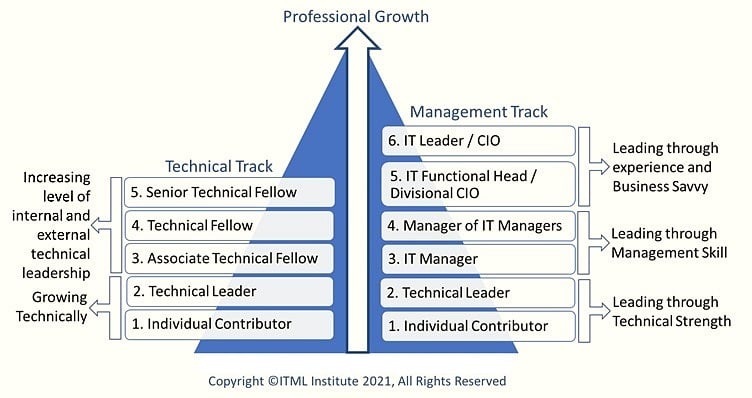The journey from individual contributor to senior IT executive involves many twists and turns, the acquisition of new skills, and a continually broadening perspective of both business and technology.
IT Management and Leadership Institute (ITML) research has identified six specific stages of leadership development. These stages are:
Level 1: Individual Contributor
Level 2: Technical Leader
Level 3: IT Manager
Level 4: Manager of IT Managers
Level 5: IT Functional Head / Divisional CIO
Level 6: Top IT Leader / CIO
Each of these levels brings with it a specific set of necessary skills, management responsibilities, business knowledge, and organizational understanding. The importance of knowing each level’s characteristics is the basis for hiring, task assignment, performance measurement, training needs, and promotional evaluation.
Traits of Future IT Leaders
Individual Contributors (Level 1) may be new to the profession or have many years of experience and be very highly skilled. In either case, their current management skills cannot yet be properly observed because they have no management responsibilities. What can be observed, however, are their communication skills, confidence level, informal leadership style, and emotional intelligence. Their future leadership potential can be assessed by observing their interactions with their peers.
Technical Leaders (Level 2) may officially be individual contributors or may be designated as Technical Leads/Supervisors. In this role, they tend to lead by technical strength rather than management ability. Their future management and leadership potential can be assessed by observing how they interact with their peers and subordinates, and their natural ability to provide guidance, mentoring, and work direction to those under their supervision.
Figure 1: IT Leader Identification, Growth and Maturity Model

Skills of the Successful IT Manager
IT Managers (Level 3) have formal first-line management responsibilities. Based on their years of management experience, they have developed (or are developing) the general managerial skills and knowledge needed to properly lead and motivate their team. These skills include delegation, running meetings, providing positive and constructive feedback, writing performance reviews, and other related tasks.
Formal training on how to perform these key managerial tasks must be provided prior to, or soon after, the person is promoted into their first management role. These types of skills are learned, not innately known. Companies that do not provide management training early on place both the new manager and their entire staff at risk of failure and/or attrition. The new manager is at risk because they haven’t been taught the basic skills needed to perform his or her job responsibilities. The new manager’s entire team is at risk because they now report to an untrained manager.
Manager of IT Managers (Level 4) may have a Senior Manager, Director, or VP title, but are not yet responsible for a major IT silo such as the Project Management Office (PMO), Application Development, or Data Center Operations. This Level 4 designation is most typical in large, multi-level IT organizations, but may be skipped in mid-size and smaller IT shops with flatter IT organizational structures. Senior Managers, Directors, and VPs with IT functional or divisional responsibility fall under Levels 5 or 6 based on their organizational responsibility.
These managers of managers need the same skill set as first-line managers, except that their direct reports now have supervisory responsibilities. The added skills needed at this level are related to gaining a deeper understanding of the business of IT, increased political savvy to deal with internal IT and company politics, cost center management, organizational design, and an expanded understanding of general company operations and industry best practices.
Skills Required of IT Functional Heads and CIOs
IT Functional Heads and Divisional CIOs (Level 5) now have full responsibility for a specific IT function, such as the PMO, Infrastructure and Operations, Software Development, or all IT activities within a specific business area or geographical region. These roles require true leadership abilities, not just management skills. This new leadership component is critical because they are now defining and driving the vision for an area of IT.
IT leaders at this level must:
- Look internally into their IT function to assure it is efficient and effective,
- Look horizontally across IT, to assure the proper support of, and coordination with, other IT silos and business functions are being provided, and
- Look externally to gain an understanding of technical trends, best practices, and key vendors related to the IT function they are leading.
Top IT Leaders, Chief Information Officers (CIO) (Level 6), in title or function, obviously run IT. When IT leaders move into this role for the first time, they soon realize that leading IT is very different than working within it.
This role brings with it many “firsts”. It is the first time that:
- The incumbent reports to a non-IT business executive
- Their peers are not other IT professionals
- They are truly driving the IT vision
- They are included in fully cross-functional business meetings with other organizational leaders.
- They (hopefully) have a seat at the business strategy table
For these reasons, the role of CIO is very different from any other leadership role within IT.
|
Please participate in ITML Institute's ongoing IT leadership research:
|


Written by Eric Bloom
Eric Bloom is the Executive Director of the IT Management and Leadership Institute, a leading provider of IT leadership, interpersonal communication, and business skills training and certification. Eric is also an Amazon #1 bestselling author, former nationally syndicated columnist, Certified Professional Speaker (CSP), TEDx Talk speaker, trainer, CIO.com contributor, past President of National Speakers Association (NSA) New England, and an IDC Research Advisor. His books include the Amazon #1 bestseller “Productivity Driven Success: Hidden Secrets of Organizational Efficiency”, Office Influence: Get what you want, from the mailroom to the boardroom, and "The CIO’s Guide to Staff Needs, Growth, and Productivity."



